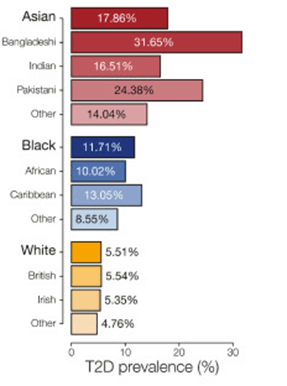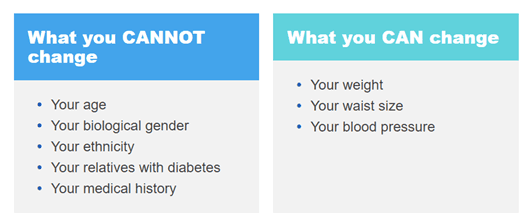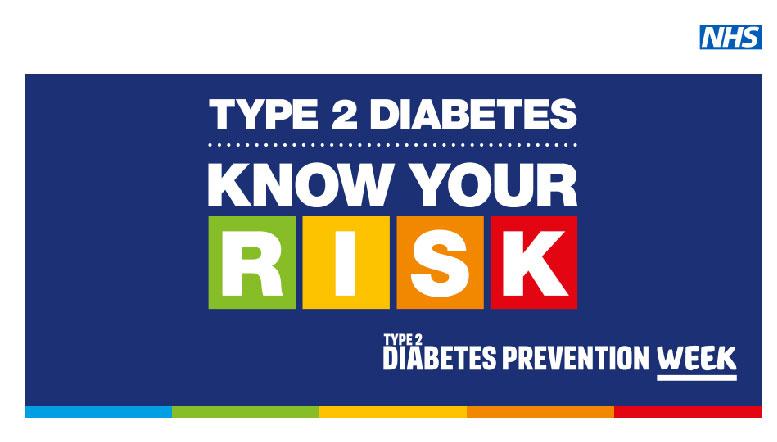The World Health Organisation (WHO) describes diabetes as a chronic, metabolic disease characterised by elevated levels of blood glucose (or blood sugar). Over time diabetes can lead to serious damage to the heart, blood vessels, eyes, kidneys, and nerves. The incidence of diabetes has almost trebled in the past 40 years!
Type 2 diabetes is the most common form of diabetes, with around 90% of people with diabetes having Type 2 diabetes. Most often diagnosed in adults, occurring when the body becomes resistant to insulin or makes insulin but doesn't make enough insulin.
We are now experiencing an increase in Type 2 diabetes which is of epidemic proportions. The main drivers of this Type 2 diabetes epidemic are the global rise in obesity, sedentary lifestyles, high calorie diets and population aging, which have quadrupled the incidence and prevalence of Type 2 diabetes (Chatterjee et al. 2007).
As we find out more about Type 2 diabetes it is becoming evident that some people are more likely to develop Type 2 diabetes than others, we call these risk factors.
Risk Factors
If you have a parent, sibling, or child with diabetes, you are two to six times more likely to develop Type 2 diabetes.
If you are genetically male, you are slightly more likely to develop Type 2 diabetes.
If you have ever had high blood pressure your risk of developing Type 2 diabetes is increased.
Having a high waist measurement increases your chances of Type 2 diabetes.
If you’re living with obesity or are overweight, there is a significant increase of the risk in developing Type 2 diabetes.
You’re more at risk if you’re white and over 40 or over 25 if you’re African-Caribbean, Black African, Chinese, or South Asian.
It has been found that Type 2 diabetes is two to four times more likely in people of South Asian descent and African-Caribbean or Black African descent. (Diabetes UK)
Research from Nagar et al. 2021 found that the prevalence of Type 2 diabetes was higher within certain ethnic groups compared to the prevalence seen in white ethnic groups, this can be seen in the graph below.

Whilst we know of the heightened risks for people from certain ethnic groups, there is little research to help identify why.
You can find out your risk of developing Type 2 diabetes by using the check your risk calculator.
A person cannot reduce all risk factors, including their ethnicity, and we call these risk factors nonmodifiable risk factors (What you CANNOT change). However, there are some risk factors, which are major causative risk factors, that we can reduce, these we call modifiable risk factors (What you CAN change).

We can make lifestyle changes to help reduce our chances of developing high blood pressure, reduce our weight and our waist measurement. Lifestyle changes that can help you reduce the risk of developing Type 2 diabetes include:
Being physical active
The UK Chief Medical Officers Physical Guidelines recommend we:
Aim for at least 150 minutes of moderate intensity activity (swimming, brisk walk, cycling) each week or at least 75 minutes of vigorous intensity activity (take the stairs, running, sports). Or a combination of both!
Partake in activity to improve balance such as dancing, playing bowls and Tai Chi. Improving balance is especially important for older adults to help reduce the chance of falls and becoming frail.
Keep muscles, bones, and joints strong by building strength. These activities we should look to do at least 2 days a week, includes using the gym, Yoga or carrying heavy bags.
Minimise sedentary time by moving around and reducing the time sitting still.
Find out more about the Guidelines here.
Eating a healthy diet
Don’t over consume unnecessary calories.
Eat plenty of fruit and vegetables, they are packed with nutrients (antioxidants, vitamins, minerals, and fibre) and will make you feel fuller for longer. The WHO recommends 400g or 5 portions of fruit and vegetables per day and 25g of fibre per day.
Eat wholegrain foods, they have fibre, protein and B vitamins and they also help you feel fuller for longer.
Ensure protein is included as part of your diet, every day. Protein helps to ensure good bone, muscle and skin health. It is recommended to have at least two portions of fish a week and to choose plant based food more often.
Keep salt intake to a maximum of maximum 6g per day.
Watch the amount of saturated fats, the recommended amounts are 30g if male and 20g if female.
Limit highly processed foods such as biscuits, hot dogs, deli meats, ready meals and fast food.
Drink water, it’s the best fluid to keep you hydrated and doesn’t have any calories!
The Eatwell Guide provides more details about the types and amounts of different foods that are healthy for us to consume
Getting enough quality sleep
Aim for 7-9 hrs per night.
Not enough sleep can lead to an average increase of 385 kcals being consumed the next day which can contribute to gaining weight and becoming overweight or obese.
Things to help get a better nights sleep:
Set a bedtime and wake up time.
Keep your bedroom quiet, consider keeping electronic devices like TVs, computers and smart phones away from the room you sleep in.
Sleep in a dark room, so close the curtains if possible.
Have a hot shower or bath before bed helps raise body temp.
Exercising during the day can also help sleep but don’t exercise too close to bedtime.
Stopping smoking
People who smoke cigarettes are 30%–40% more likely to develop Type 2 diabetes than people who don't smoke. The more cigarettes someone smokes, the higher risk of developing Type 2 diabetes. The chemicals in tobacco including cigarettes, causes harm to our cells which causes inflammation. The inflammatory process effects cells and stops them responding to insulin. These chemicals also cause a reaction called oxidate stress in the body, which describes the damage to cells that occur when cigarette smoke mixes with oxygen in our body.
Consider joining a programme to help you to stop smoking.
Reducing alcohol intake
Alcoholic beverages can be high in sugar and high in calories, which can lead to a gain in weight. It is best to avoid alcoholic drinks that are high in sugar and opt for drinks with lower levels of alcohol. Government guidelines state to consume a maximum of 14 units of alcohol per week. And to space out these 14 units over the week.
Alcohol does lead to dehydration too! When we become dehydrated or don’t drink enough water, the glucose in our bloodstream becomes more concentrated. And that leads to higher levels of circulating glucose levels. Aim to stay within the Government guidelines and supplement another alcoholic drink with a drink that is low in calories or has no calories, such as water.
There is more information about what an alcohol unit is and how to control drinking alcohol on the NHS Website.

